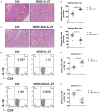IL-27 Regulated CD4+IL-10+ T Cells in Experimental Sjögren Syndrome
- PMID: 32849596
- PMCID: PMC7431603
- DOI: 10.3389/fimmu.2020.01699
IL-27 Regulated CD4+IL-10+ T Cells in Experimental Sjögren Syndrome
Abstract
Interleukin 27 (IL-27) plays diverse immune regulatory roles in autoimmune disorders and promotes the generation of IL-10-producing CD4+ T cells characterized by producing the immunosuppressive cytokine IL-10. However, whether IL-27 participates in pathological progress of Sjögren syndrome (SS) through regulating CD4+IL-10+ T cells remains unknown. Here we aimed to explore the potential role of IL-27 and CD4+IL-10+ T cells in the pathogenesis of SS. The IL-27 gene knockout non-obese diabetic (Il-27-/-NOD) mice were generated and injected with exogenous IL-27. Exogenous injection of IL-27 and neutralization of IL-27 with anti-IL-27 antibody in NOD mice were performed. The histopathologic changes in submandibular glands, lacrimal glands and lung, salivary flow rate, and percentages of CD4+IL-10+ T cells were determined. And, ovalbumin-immunized C57L/B6 mice were injected with IL-27 to detect the percentage of CD4+IL-10+ T cells. In vitro, splenic naive T cells from C57L/B6 mice were cultured with IL-27 for 4 days to induce the differentiation of CD4+IL-10+ T cells. In addition, IL-27, IL-10, and CD4+IL-10+ T cells were determined in health control and SS patients. The results showed that Il-27-/-NOD mice had more severe disease and lower level of CD4+IL-10+ T cells than control mice. And IL-27 promoted the generation and differentiation of CD4+IL-10+ T cells in vivo and in vitro significantly. In agreement with the findings in the SS-like mice, patients with SS showed lower levels of IL-27, IL-10, and CD4+IL-10+ T cells. Our findings indicated that IL-27 deficiency aggravated SS by regulating CD4+IL-10+ T cells. Targeting IL-27 and CD4+IL-10+ T cells may be a novel therapy for patients with SS.
Keywords: CD4+IL-10+ T cells; Sjögren syndrome; immunosuppression; interleukin-10; interleukin-27.
Copyright © 2020 Qi, Zhang, Tang, Li, Chen and Yao.
Figures





Similar articles
-
Local suppression of IL-21 in submandibular glands retards the development of Sjögren's syndrome in non-obese diabetic mice.J Oral Pathol Med. 2012 Nov;41(10):728-35. doi: 10.1111/j.1600-0714.2012.01175.x. Epub 2012 May 29. J Oral Pathol Med. 2012. PMID: 22643047
-
Interleukin-21-mediated suppression of the Pax3-Id3 pathway exacerbates the development of Sjögren's syndrome via follicular helper T cells.Cytokine. 2020 Jan;125:154834. doi: 10.1016/j.cyto.2019.154834. Epub 2019 Sep 3. Cytokine. 2020. PMID: 31491724
-
Altered characteristics of regulatory T cells in target tissues of Sjögren's syndrome in murine models.Mol Immunol. 2024 Oct;174:47-56. doi: 10.1016/j.molimm.2024.08.003. Epub 2024 Aug 27. Mol Immunol. 2024. PMID: 39197397
-
Involvement of Aquaporins in the Pathogenesis, Diagnosis and Treatment of Sjögren's Syndrome.Int J Mol Sci. 2018 Oct 30;19(11):3392. doi: 10.3390/ijms19113392. Int J Mol Sci. 2018. PMID: 30380700 Free PMC article. Review.
-
Pathogenesis of Sjögren's syndrome-like autoimmune lesions in MRL/lpr mice.Pathol Int. 1994 Aug;44(8):559-68. doi: 10.1111/j.1440-1827.1994.tb01716.x. Pathol Int. 1994. PMID: 7952145 Review.
Cited by
-
IL-6-targeted therapies to block the cytokine or its receptor drive distinct alterations in T cell function.JCI Insight. 2022 Nov 22;7(22):e159436. doi: 10.1172/jci.insight.159436. JCI Insight. 2022. PMID: 36282595 Free PMC article.
-
Recent Insights Into Targeting Interleukin-27 in Coronary Artery Disease.J Cardiovasc Transl Res. 2025 Jul 7. doi: 10.1007/s12265-025-10656-5. Online ahead of print. J Cardiovasc Transl Res. 2025. PMID: 40622445 Review.
-
Sjögren syndrome: looking forward to the future.Ther Adv Musculoskelet Dis. 2022 May 23;14:1759720X221100295. doi: 10.1177/1759720X221100295. eCollection 2022. Ther Adv Musculoskelet Dis. 2022. PMID: 35634352 Free PMC article. Review.
-
Old and New Players of Inflammation and Their Relationship With Cancer Development.Front Oncol. 2021 Nov 22;11:722999. doi: 10.3389/fonc.2021.722999. eCollection 2021. Front Oncol. 2021. PMID: 34881173 Free PMC article. Review.
-
Endometrial Regenerative Cell-Derived Conditioned Medium Alleviates Experimental Colitis.Stem Cells Int. 2022 Jan 27;2022:7842296. doi: 10.1155/2022/7842296. eCollection 2022. Stem Cells Int. 2022. PMID: 35126527 Free PMC article.
References
Publication types
MeSH terms
Substances
LinkOut - more resources
Full Text Sources
Medical
Research Materials

